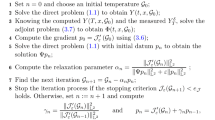Abstract
In this paper, the conjugate gradient method coupled with adjoint problem is used to solve the inverse heat conduction problem (IHCP) and estimation of the time-dependent heat flux using the temperature distribution at a point. In addition, the effects of noisy data and position of measured temperature on final solution are studied. The numerical solution of the governing equations is obtained by employing a finite-difference technique. For solving this problem, the general coordinate method is used. We solve the IHCP of estimating the transient heat flux, applied on part of the boundary of an irregular region. The irregular region in the physical domain (r, z) is transformed into a rectangle in the computational domain (ξ, η). The present formulation is general and can be applied to the solution of boundary IHCP over any region that can be mapped into a rectangle. The obtained results for few selected examples show the good accuracy of the presented method. In addition, the solutions have good stability even if the input data includes noise and that the results are nearly independent of sensor position.

Similar content being viewed by others
References
Huang C.H., Wang P.: A three-dimensional inverse heat conduction problem in estimating surface heat flux by conjugate gradient method. Int. J. Heat Mass Transfer 42, 3387–3403 (1999)
Shiguemori E.H., Harter F.P., Campos Velho H.F., da Silva J.D.S.: Estimation of boundary conditions in conduction heat transfer by neural networks. Tendências em Matemática Aplicada e Computacional 3(2), 189–195 (2002)
Volle F., Maillet D., Gradeck M., Kouachi A., Lebouché M.: Practical application of inverse heat conduction for wall condition estimation on a rotating cylinder. Int. J. Heat Mass Transfer 52, 210–221 (2009)
Golbahar Haghighi M.R., Eghtesad M., Malekzadeh P., Necsulescu D.S.: Three-dimensional inverse transient heat transfer analysis of thick functionally graded plates. Energy Conversion Manage. 50, 450–457 (2009)
Su J., Neto A.: Two dimensional inverse heat conduction problem of source strength estimation in cylindrical rods. Appl. Math. Model. 25, 861–872 (2001)
Hsu P.T.: Estimating the boundary condition in a 3D inverse hyperbolic heat conduction problem. Appl. Math. Comput. 177, 453–464 (2006)
Shi J., Wang J.: Inverse problem of estimating space and time dependent hot surface heat flux in transient transpiration cooling process. Int. J. Thermal Sci. 48, 1398–1404 (2009)
Ling, X.; Atluril, S.N.: Stability analysis for inverse heat conduction problems. CMES 13(3), 219–228 (2006). Technical Science Press
Jiang B.H., Nguyen T.H., Prud’homme M.: Control of the boundary heat flux during the heating process of a solid material. Int. Commun. Heat Mass Transfer 32, 728–738 (2005)
Chen S.G., Weng C.I., Lin J.: Inverse estimation of transient temperature distribution in the end quenching test. J. Mater. Process. Technol. 86, 257–263 (1999)
Chen C.-K., Wu L.-W., Yang Y.-T.: Application of the inverse method to the estimation of heat flux and temperature on the external surface in laminar pipe flow. Appl. Thermal Eng. 26, 1714–1724 (2006)
Yang Y.C., Chu S.S., Chang W.J., Wu T.S.: Estimation of heat flux and temperature distributions in a composite strip and homogeneous foundation. Int. Commun. Heat Mass Transfer 37, 495–500 (2010)
Chen T.C., Liu C.C., Jang H.Y., Tuan P.C.: Inverse estimation of heat flux and temperature in multi-layer gun barrel. Int. J. Heat Mass Transfer 50, 2060–2068 (2007)
Jarny Y., Ozisik M.N., Bardon J.P.: A general optimization method using adjoint equation for solving multidimensional inverse heat conduction. J. Heat Mass Transfer 34, 2911–2919 (1991)
Daniel J.W.: Approximate Minimization of Functionals. Prentice-Hall, Englewood Cliffs (1971)
Ozisik M.N., Orlando R.B.: Inverse Heat Transfer. Taylor & Francis, New York (2000)
Ozisik M.N.: Heat Conduction, 2nd edn. Wiley, New York (1993)
Alifanov O.M.: Inverse Heat Transfer Problems. Springer, New York (1994)
Author information
Authors and Affiliations
Corresponding author
Rights and permissions
About this article
Cite this article
Mohammadiun, M., Rahimi, A.B. Estimation of the Time-Dependent Heat Flux Using the Temperature Distribution at a Point. Arab J Sci Eng 38, 971–981 (2013). https://doi.org/10.1007/s13369-012-0522-9
Received:
Accepted:
Published:
Issue Date:
DOI: https://doi.org/10.1007/s13369-012-0522-9




